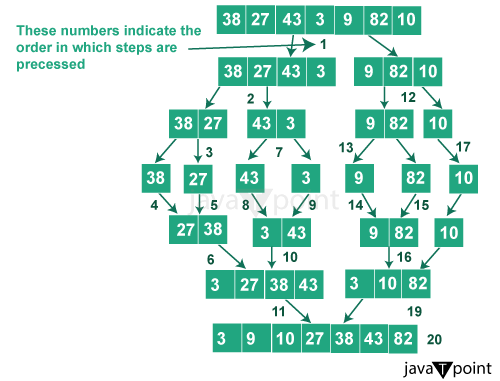Two-way merge sortOverview of Merge SortMerge Sort is an efficient and easy-to-implement sorting algorithm that uses the divide-and-conquer approach. It breaks down the problem into smaller sub-problems to process them individually and then joins them to make one complete sorted list. The divide step in Merge Sort entails dividing the array in half and recursively sorting each half. The conquer step involves merging the sorted sub-arrays to get the final sorted array. The merging stage of Merge Sort, which combines two sorted sub-arrays into a single sorted array, takes the longest. Two-Way Merge SortTwo-way merge Sort merges two sorted lists into one sorted list. In Merge Sort, it is commonly used to produce the smallest item in each step-given list sorted by length and to produce a sorted list that contains all the items in any input list proportionate to the total length of the input lists. Unlike K-Way Merge Sort, which merges K-sorted lists, Two-Way Merge Sort merges only two sorted lists. How Two-Way Merge Sort WorksThe Two-Way Merge Sort algorithm divides, sorts, and merges a list to create a complete sorted list. It selects the smaller element during the merging process. Here are the steps for the implementation of two-way merge sort:
Example:Output: [3,9,10,27,38,43,82] 
This code sorts an input array using the merge sort algorithm. It checks if the array has one or zero elements and returns them as is. For arrays with more than one element, the code splits them into two halves and sorts each half using merge_Sort(). The sorted halves are merged using the merge() function, which adds the smaller element of each half to the output array until all elements are added. The sorted array is then returned. Merge_Sort() sorts an unsorted array in ascending order. You can modify merge() to sort in descending order. Advantages:
Disadvantages:
Merge sort is efficient with a time complexity of O(n log n), making it ideal for large datasets. However, it requires extra space for temporary arrays during merging, which can be a disadvantage when dealing with large datasets. Let's compare the Two-way merge sort with other merge sorting techniques, precisely the Three-way merge sort and K-way merge sort.
Two-way merge sort is a sorting algorithm that uses the divide-and-conquer approach to sort an input array by splitting it into two halves, sorting each half separately, and merging them back together. This method is commonly used in Merge Sort to output the minimum item in each step given a list in sorted order. Furthermore, it builds a sorted list with all items in proportion to the total length of the input lists.
Merge sort is a popular sorting algorithm that recursively divides an array into subarrays of size half. Three-way merge sort is a variation of merge sort that divides the array into three parts instead of two. In this algorithm, the array is broken down into subarrays of size one-third, which can lead to a more balanced tree and fewer comparisons overall. However, implementing this algorithm requires more complex code and may result in more comparisons at each step.
K-way merge sort is a variation of the merge sort algorithm. When dealing with large external data sets, dividing an array into K parts instead of two can improve efficiency. This is because reading a block of data takes less time than reading individual elements. However, this method requires a more complex merging process and potentially more comparisons at each step. ConclusionOverall, the Two-Way Merge Sort is a powerful tool in the arsenal of any programmer or computer scientist. Whether you're sorting a small array or a large dataset, understanding how this algorithm works can help you choose the right tool. |
 For Videos Join Our Youtube Channel: Join Now
For Videos Join Our Youtube Channel: Join Now
Feedback
- Send your Feedback to [email protected]
Help Others, Please Share










